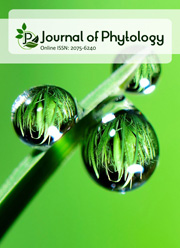Analysis of secondary structure and identification of internal repeats in miRNA precursor sequences of Saccharum officinarum, Saccharum sp. and Sorghum bicolor
DOI:
https://doi.org/10.25081/cb.2025.v16.9057Keywords:
Expressed sequence tags (ESTs), miRNAs, pre-miRNAs, Secondary structure, Simple Sequence Repeats (SSRs)Abstract
MicroRNAs (miRNAs) are the post-transcriptional regulators of gene expression that interact with mRNA in a sequence-specific manner. These interactions are primarily regulated by the secondary structural conformation of miRNAs. In plants, miRNAs have always been a subject to extensive research to see their explicit roles in overall development, cell to cell communications, metabolism, responses to stress and pathogen invasion. Here, we aimed to gain more understanding of the secondary structure of all possible miRNA precursor sequences (pre-miRNAs from which mature miRNAs are produced) for Saccharum and Sorghum, the two closest monocot relatives among the domesticated cultivated crops. Using computational approaches, altogether, 240 different pre-miRNAs were analyzed among which three different structural patterns were observed. The structural motifs primarily consist of stem, internal loop, bulge, and terminal loop. The pre-miRNAs of Saccharum sp. were found to have the most stable secondary structure with -193.05 kcal/mol free energy suggesting their resistance to nuclease in the cell. The Simple Sequence Repeats (SSRs) within the stem region of pre-miRNAs were found to be predominant with many trinucleotides, tetranucleotides and less frequent pentanucleotide repeats. AUG/AUC was the mostly observed trinucleotide in 80 percent of the studied precursors. The occurrence of these repeat sequences at varying level suggests their role in the proper functioning of miRNAs. Likewise, SSRs provide a molecular basis for the structural conformation of pre-miRNAs. All this information is substantially required for identifying miRNA targets and designing additional miRNA-based strategies to increase crop yields and enhance plant resistance to environmental stresses.
Downloads
References
Attri, K., Zhang, Z., Singh, A., Sharrock, R. A., & Xie, Z. (2022). Rapid sequence and functional diversification of a miRNA superfamily targeting calcium signaling components in seed plants. The New phytologist, 235(3), 1082-1095. https://doi.org/10.1111/nph.18185
Bajczyk, M., Jarmolowski, A., Jozwiak, M., Pacak, A., Pietrykowska, H., Sierocka, I., Swida-Barteczka, A., Szewc, L., & Szweykowska-Kulinska, Z. (2023). Recent Insights into Plant miRNA Biogenesis: Multiple Layers of miRNA Level Regulation. Plants, 12(2), 342. https://doi.org/10.3390/plants12020342
Chakraborty, A., Viswanath, A., Malipatil, R., Rathore, A., & Thirunavukkarasu, N. (2020). Structural and Functional Characteristics of miRNAs in Five Strategic Millet Species and Their Utility in Drought Tolerance. Frontiers in Genetics, 11, 608421. https://doi.org/10.3389/fgene.2020.608421
Chen, X., Liu, J., Cheng, Y., & Jia, D. (2002). HEN1 functions pleiotropically in Arabidopsis development and acts in C function in the flower. Development, 129(5), 1085-1094. https://doi.org/10.1242/dev.129.5.1085
Chuck, G., Meeley, R., Irish, E., Sakai, H., & Hake, S. (2007). The maize tasselseed4 microRNA controls sex determination and meristem cell fate by targeting Tasselseed6/indeterminate spikelet1. Nature Genetics, 39(12), 1517-1521. https://doi.org/10.1038/ng.2007.20
De la Rosa, C., Lozano, L., Castillo-Ramírez, S., Covarrubias, A. A., & Reyes, J. L. (2020). Origin and Evolutionary Dynamics of the miR2119 and ADH1 Regulatory Module in Legumes. Genome Biology and Evolution, 12(12), 2355-2369. https://doi.org/10.1093/gbe/evaa205
Gupta, S. G., Basu, S., & Ganguli, S. (2022). Repetitive sequences in monocot microRNAs - targets for future bioengineering strategies for climate resilient crops. Journal of Environment and Sociobiology, 19(2), 295-306.
Heikkinen, L., Asikainen, S., & Wong, G. (2008). Identification of phylogenetically conserved sequence motifs in microRNA 5' flanking sites from C. elegans and C. briggsae. BMC Molecular Biology, 9, 105. https://doi.org/10.1186/1471-2199-9-105
Huberdeau, M. O., & Simard, M. J. (2019). A guide to microRNA-mediated gene silencing. The FEBS Journal, 286(4), 642-652. https://doi.org/10.1111/febs.14666
Islam, W., Tauqeer, A., Waheed, A., & Zeng, F. (2022). MicroRNA Mediated Plant Responses to Nutrient Stress. International Journal of Molecular Sciences, 23(5), 2562. https://doi.org/10.3390/ijms23052562
Iwakawa, H.-O., & Tomari, Y. (2015). The Functions of MicroRNAs: mRNA Decay and Translational Repression. Trends in Cell Biology, 25(11), 651-665. https://doi.org/10.1016/j.tcb.2015.07.011
Jonas, S., & Izaurralde, E. (2015). Towards a molecular understanding of microRNA-mediated gene silencing. Nature Reviews Genetics, 16, 421-433. https://doi.org/10.1038/nrg3965
Kaur, S., Seem, K., Kumar, D., Kumar, S., Kaundal, R., & Mohapatra T. (2024). Biogenesis to functional significance of microRNAs under drought stress in rice: Recent advances and future perspectives. Plant Stress, 12, 100447. https://doi.org/10.1016/j.stress.2024.100447
Kidner, C. A., & Martienssen, R. A. (2004). Spatially restricted microRNA directs leaf polarity through ARGONAUTE1. Nature, 428(6978), 81-84. https://doi.org/10.1038/nature02366
Kravchik, M., Stav, R., Belausov, E., & Arazi, T. (2019). Functional Characterization of microRNA171 Family in Tomato. Plants, 8(1), 10. https://doi.org/10.3390/plants8010010
Lauter, N., Kampani, A., Carlson, S., Goebel, M., & Moose, S. P. (2005). microRNA172 down-regulates glossy15 to promote vegetative phase change in maize. Proceedings of the National Academy of Sciences of the United States of America, 102(26), 9412–9417. https://doi.org/10.1073/pnas.0503927102
Mallory, A. C., & Bouché, N. (2008). MicroRNA-directed regulation: to cleave or not to cleave. Trends in Plant Science, 13(7), 359-367. https://doi.org/10.1016/j.tplants.2008.03.007
Ming, R., Liu, S.-C., Lin, Y.-R., da Silva, J., Wilson, W., Braga, D., van Deynze, A., Wenslaff, T. F., Wu, K. K., Moore, P. H., Burnquist, W., Sorrells, M. E., Irvine, J. E., & Paterson, A. H. (1998). Detailed alignment of saccharum and sorghum chromosomes: comparative organization of closely related diploid and polyploid genomes. Genetics, 150(4), 1663-1682. https://doi.org/10.1093/genetics/150.4.1663
Narjala, A., Nair, A., Tirumalai, V., Hari Sundar, G. V., & Shivaprasad, P. V. (2020). A conserved sequence signature is essential for robust plant miRNA biogenesis. Nucleic Acids Research, 48(6), 3103-3118. https://doi.org/10.1093/nar/gkaa077
Pagano, L., Rossi, R., Paesano, L., Marmiroli, N., & Marmiroli, M. (2021). miRNA regulation and stress adaptation in plants. Environmental and Experimental Botany, 184, 104369. https://doi.org/10.1016/j.envexpbot.2020.104369
Paul, S., Datta, S. K., & Datta, K. (2015). miRNA regulation of nutrient homeostasis in plants. Frontiers in Plant Science, 6, 232. https://doi.org/10.3389/fpls.2015.00232
Pegler, J. L., Oultram, J. M. J., Grof, C. P. L., & Eamens, A. L. (2019). Profiling the Abiotic Stress Responsive microRNA Landscape of Arabidopsis thaliana. Plants, 8(3), 58. https://doi.org/10.3390/plants8030058
Pilon, M. (2017). The copper microRNAs. New Phytologist, 213(3), 1030-1035. https://doi.org/10.1111/nph.14244
Reinhart, B. J., Weinstein, E. G., Rhoades, M. W., Bartel, B., & Bartel, D. P. (2002). MicroRNAs in plants. Genes & Development, 16, 1616-1626. https://doi.org/10.1101/gad.1004402
Rhoades, M. W., Reinhart, B. J., Lim, L. P., Burge, C. B., Bartel, B., & Bartel, D. P. (2002). Prediction of plant microRNA targets. Cell, 110(4), 513-520. https://doi.org/10.1016/s0092-8674(02)00863-2
Rooney, L. W., & Saldivar, S. O. (2003). Sorghum. In B. Caballero, L. C. Trugo & P. M. Finglas (Eds.), Encyclopedia of Food Sciences and Nutrition (Vol. 8, pp. 5370-5375) London, UK: Academic Press.
Salvi, S., Sponza, G., Morgante, M., Tomes, D., Niu, X., Fengler, K. A., Meeley, R., Ananiev, E. V., Svitashev, S., Bruggemann, E., Li, B., Hainey, C. F., Radovic, S., Zaina, G., Rafalski, J.-A., Tingey, S. V., Miao, G.-H., Phillips, R. L., & Tuberosa, R. (2007). Conserved noncoding genomic sequences associated with a flowering-time quantitative trait locus in maize. Proceedings of the National Academy of Sciences of the United States of America, 104(27), 11376-11381. https://doi.org/10.1073/pnas.0704145104
Samynathan, R., Venkidasamy, B., Shanmugam, A., Ramalingam, S., & Thiruvengadam, M. (2023). Functional role of microRNA in the regulation of biotic and abiotic stress in agronomic plants. Frontiers in Genetics, 14, 1272446. https://doi.org/10.3389/fgene.2023.1272446
Thiebaut, F., Grativol, C., Carnavale-Bottino, M., Rojas, C. A., Tanurdzic, M., Farinelli, L., Martienssen, R. A., Hemerly, A. S., & Ferreira, P. C. (2012). Computational identification and analysis of novel sugarcane microRNAs. BMC Genomics, 13, 290. https://doi.org/10.1186/1471-2164-13-290
Vieira, M. L. C., Santini, L., Diniz, A. L., & Munhoz, C. de F. (2016). Microsatellite markers: what they mean and why they are so useful. Genetics and Molecular Biology, 39(3), 312-328. https://doi.org/10.1590/1678-4685-GMB-2016-0027
Voinnet, O. (2009). Origin, biogenesis, and activity of plant microRNAs. Cell, 136(4), 669-687. https://doi.org/10.1016/j.cell.2009.01.046
Wang, H., & Wang, H. (2015). The miR156/SPL Module, a Regulatory Hub and Versatile Toolbox, Gears up Crops for Enhanced Agronomic Traits. Molecular Plant, 8(5), 677-688. https://doi.org/10.1016/j.molp.2015.01.008
Wang, H., Li, Y., Chern, M., Zhu, Y., Zhang, L.-L., Lu, J.-H., Li, X.-P., Dang, W.-Q., Ma, X.-C., Yang, Z.-R., Yao, S.-Z., Zhao, Z.-X., Fan, J., Huang, Y.-Y., Zhang, J.-W., Pu, M., Wang, J., He, M., Li, W.-T. … Wang, W.-M. (2021). Suppression of rice miR168 improves yield, flowering time and immunity. Nature Plants, 7, 129-136. https://doi.org/10.1038/s41477-021-00852-x
Wang, X.-J., Reyes, J. L., Chua, N.-H., & Gaasterland, T. (2004). Prediction and identification of Arabidopsis thaliana microRNAs and their mRNA targets. Genome Biology, 5, R65. https://doi.org/10.1186/gb-2004-5-9-r65
Wong, G. Y., & Millar, A. A. (2023). Target Landscape of Conserved Plant MicroRNAs and the Complexities of Their Ancient MicroRNA-Binding Sites. Plant & Cell Physiology, 64(6), 604-621. https://doi.org/10.1093/pcp/pcad019
Xu, Y., & Chen, X. (2023). microRNA biogenesis and stabilization in plants. Fundamental Research, 3(5), 707-717. https://doi.org/10.1016/j.fmre.2023.02.023
Yang, R., Li, P., Mei, H., Wang, D., Sun, J., Yang, C., Hao, L., Cao, S., Chu, C., Hu, S., Song, X., & Cao, X. (2019). Fine-Tuning of MiR528 Accumulation Modulates Flowering Time in Rice. Molecular Plant, 12(8), 1103-1113. https://doi.org/10.1016/j.molp.2019.04.009
Yu, L., Yu, X., Shen, R., & He, Y. (2005). HYL1 gene maintains venation and polarity of leaves. Planta, 221, 231-242. https://doi.org/10.1007/s00425-004-1439-7
Zhang, B. H., Pan, X. P., Wang, Q. L., Cobb, G. P., & Anderson, T. A. (2005). Identification and characterization of new plant microRNAs using EST analysis. Cell Research, 15, 336-360. https://doi.org/10.1038/sj.cr.7290302
Zhang, F., Yang, J., Zhang, N., Wu, J., & Si, H. (2022). Roles of microRNAs in abiotic stress response and characteristics regulation of plant. Frontiers in Plant Science, 13, 919243. https://doi.org/10.3389/fpls.2022.919243
Published
How to Cite
Issue
Section
Copyright (c) 2025 Subhadipa Sengupta, Ashmita Singha, Sayak Ganguli

This work is licensed under a Creative Commons Attribution-NonCommercial 3.0 Unported License.



 .
.